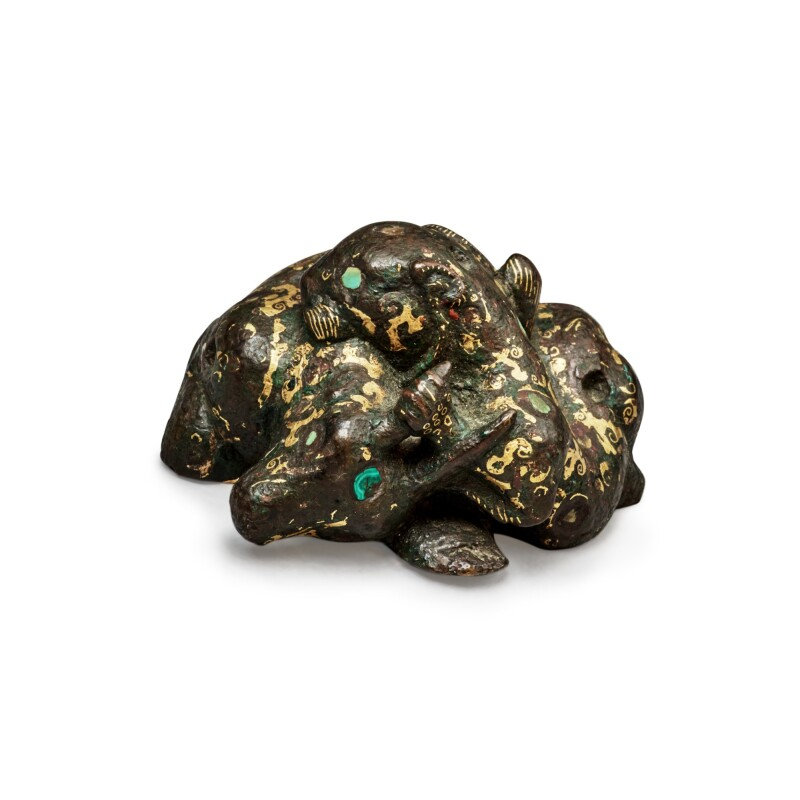A gold, turquoise and malachite-inlaid bronze weight, Early Western Han dynasty (206BC - 24AD)
Lot 7. A gold, turquoise and malachite-inlaid bronze weight, Early Western Han dynasty (206BC - 24AD). Width 2¾ in., 6.9 cm. Estimate: 20,000 - 30,000 USD. Lot sold: 88,200 USD. © Sothebys.
with a four-character inscription reading jun yi gao guan (Wish you achieve success and prosperity).
Literature: Rose Kerr et al., Chinese Antiquities from the Wou Kiuan Collection. Wou Lien-Pai Museum, Hong Kong, 2011, pl. 26.
Note: Striking for its dynamic and naturalistic form, the present weight represents the fully developed bronze sculptural tradition of the Han dynasty (206 BC - 221 AD). Mat weights crafted from precious materials such as bronze and jade, often gilded or inlaid with gold, silver or gemstones, were produced in sets of four and served a practical function of anchoring down woven mats for seating. Mats and corner-weights were believed to have been used at banquets, even those laid out in tombs. Inlaid animal-form weights were discovered in the tomb of Dou Wan, consort of Liu Sheng, Prince Jing of Zhongshan (d. 113 BC), alongside food and wine vessels.
The sculptural depiction of animals in combat was introduced to China from the nomadic and semi-nomadic cultures of Central Asia, the Eurasian steppes, and the Ordos region, and was an innovation particular to the Warring States and Han dynasty periods. During the early Western Han dynasty, the imperial Shanglin zoological park and hunting reserve adjacent to the walled city grew in size and importance. Conceived as a microcosm of the empire, it allowed the emperor and his courtiers to observe and study the various species of plants and animals known at the time. The site also served as a venue of orchestrated animal combat for the entertainment of the court.
Sotheby's. A Journey Through China's History. The Dr Wou Kiuan Collection Part 1, New York, 22 March 2022

/https%3A%2F%2Fprofilepics.canalblog.com%2Fprofilepics%2F1%2F0%2F100183.jpg)
/https%3A%2F%2Fstorage.canalblog.com%2F03%2F02%2F119589%2F96711876_o.jpg)
/https%3A%2F%2Fstorage.canalblog.com%2F11%2F31%2F119589%2F94773502_o.jpg)
/https%3A%2F%2Fstorage.canalblog.com%2F20%2F83%2F119589%2F94772815_o.jpg)
/https%3A%2F%2Fstorage.canalblog.com%2F26%2F72%2F119589%2F75604929_o.jpg)
/https%3A%2F%2Fstorage.canalblog.com%2F59%2F60%2F119589%2F26458628_o.jpg)





/http%3A%2F%2Fstorage.canalblog.com%2F28%2F46%2F119589%2F127764601_o.jpg)
/http%3A%2F%2Fstorage.canalblog.com%2F90%2F78%2F119589%2F94010755_o.jpg)
/http%3A%2F%2Fstorage.canalblog.com%2F40%2F34%2F119589%2F73755113_o.jpg)
/image%2F1371349%2F20240423%2Fob_b2fe42_telechargement-9.jpg)